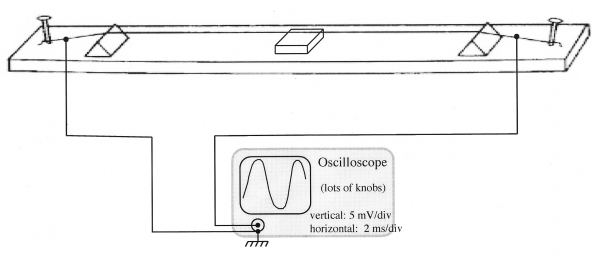What it shows:
An emf is induced between the ends of a wire moving back and forth in the presence of a magnetic field.
How it works:
The ends of a monochord wire are connected to an oscilloscope as illustrated:

Plucking the wire sideways produces no signal until a rectangular magnet is placed under the string. If the wire is plucked gently in the middle, a pure sinusoidal voltage will be displayed on the oscilloscope. Plucking it otherwise will produce harmonics which will literally be displayed as harmonic distortion of the sine wave.
The experiment can be presented quantitatively with the following information. The magnetic field strength of the 2" square magnet measures to be about 0.1 T. If you use a 5 kg weight to provide the tension in the wire, the wire will vibrate at approximately 100 Hz. Assuming that the displacement of the wire is given by x(t) = A cos(ωt), then the velocity will be v(t) = -Aω sin(ωt) with the maximum velocity equal to Aω. Having estimated A to be approximately 6 mm, we can deduce that the maximum velocity is about 3.8 m/s. Using these values, the maximum emf = vBl = (3.8 m/s)((0.1 T)(0.05 m) = 0.19 V, or approximately 20 mV. Indeed, the peak-to-peak voltage shown on the oscilloscope is about 40 mV.
Setting it up:
A large cart is all that is needed to hold the monochord and oscilloscope. A thin piece of wood needs to be placed under the magnet to bring it close to the wire. It's a steel wire, so don't bring it too close! If you wish (and this is just for fun) you can also feed the signal to an amplifier and loudspeaker.
Comments:
Bowing the string results in fascinating voltage displays. Pure slip/stick motion shows up as a square wave.